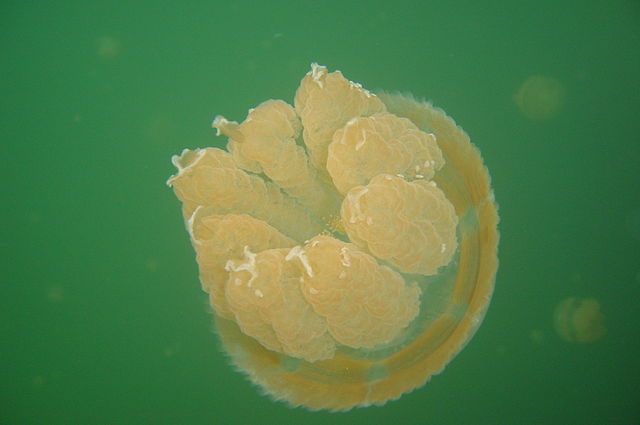Isolated saltwater lakes on remote islands of the South Pacific serve as the stage for a surprising and beautiful daily dance. Spotted jellies or golden medusae (Mastigias papua) migrate west-to-east across their lakes every day, in huge, spectacular densities. Why?
Like some other jellies, Mastigias harbor symbiotic algae in their tissues. These algae (in the group Zooxanthellae) are related to those found in coral, and have struck a similar deal with their host: the algae provide the jellies sugars from photosynthesis, and the jellies in turn provide them with nutrients from the plankton they eat. The jellies’ daily migration tracks the sun across the sky, and so maximizes the amount of photosynthesis the algae can perform, and the sugars they can furnish.
This broad arrangement, partnering a photosynthetic species with a species that excels at foraging nutrients from the environment, has been replicated many times across the tree of life. Lichens, mycorrhizae, and corals are some prominent examples that I will discuss in future posts. Like all symbioses, this partnership arose because each partner provides a service that the other cannot: the algae can migrate and consume plankton through the jellyfish, and the jellyfish can photosynthesize through the algae. But enough about evolution and ecology, check out this video!
The video suggests that these jellies only exist in these lakes, but don’t let the dulcet, manly tones of Alec Baldwin fool you: they live in the surrounding lagoons as well. In fact, jellies from this genus appear to have recently invaded the Atlantic Ocean, and other species of ocean-faring jellyfish also form symbiotic associations with algae. Mastigias jellies have indeed diverged into multiple subspecies in the lakes of Palau, however.
And yes, you can swim in one of these lakes. The jellies’ stingers are harmless to humans.
Cover photo credit: CT Snow
References:
- Bayha, Keith M., and William M. Graham. “First confirmed reports of the rhizostome jellyfish Mastigias(Cnidaria: Rhizostomeae) in the Atlantic basin.” Aquatic Invasions 6.3 (2011): 361-366. link
- Dawson, Michael N. “Five new subspecies of Mastigias (Scyphozoa: Rhizostomeae: Mastigiidae) from marine lakes, Palau, Micronesia.” Journal of the Marine Biological Association of the United Kingdom 85.3 (2005): 679-694. link

